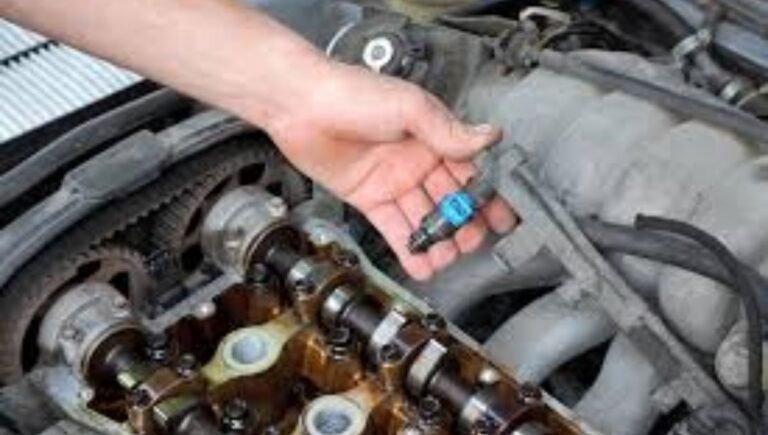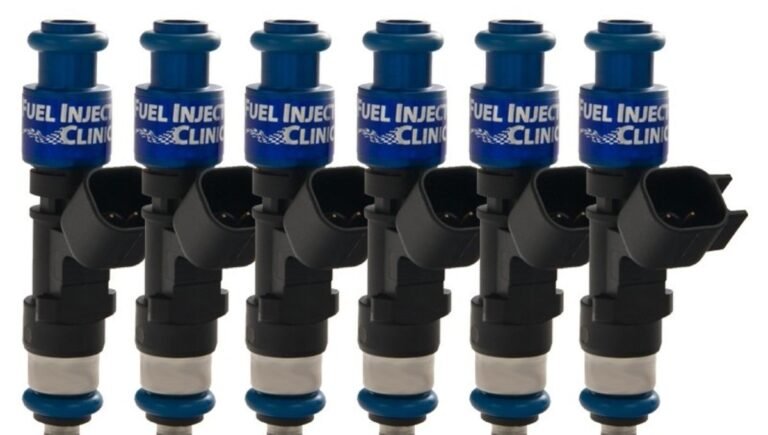How to Get Water Out of Fuel Injectors: Quick Fixes!
To get water out of fuel injectors, you can use a fuel system cleaner specifically designed to remove water from the fuel system. Using such a cleaner will help to prevent damage to the injectors and ensure proper engine performance.
Additionally, regularly checking for and fixing any leaks in the fuel system can help prevent water from entering the injectors. Proper maintenance and care of your vehicle’s fuel system is essential for optimal performance and longevity.
Introduction To Water Contamination In Fuel Systems
Water contamination in fuel systems can lead to issues with fuel injectors. To remove water from fuel injectors, use specialized fuel treatments or seek professional help for thorough cleaning. Regular maintenance helps prevent water buildup, ensuring optimal engine performance.
Water contamination in fuel systems can lead to serious issues. It is crucial to understand the causes and symptoms of water in fuel injectors to prevent damage and maintain engine performance.
Common Causes Of Water In Fuel Injectors
- Condensation from temperature changes
- Leaking seals or gaskets
- Using contaminated fuel
Symptoms Of Water-contaminated Fuel Injectors
- Engine misfires
- Decreased fuel efficiency
- Stalling or rough idling
Safety Precautions Before Starting
Before starting the process of getting water out of fuel injectors, it’s crucial to observe safety precautions. Ensure the engine is off and cool, wear protective gear, and have a fire extinguisher nearby. Disconnect the battery and relieve the fuel pressure to prevent any accidents.
Tools And Materials Needed: Ensuring A Safe Work Environment
Initial Diagnosis
When facing issues with fuel injectors, the initial diagnosis is crucial for identifying and resolving the problem. Understanding the steps for initial diagnosis can help in efficiently addressing the issue and preventing further damage.
Visual Inspection Of The Fuel System
Inspect the fuel injectors, fuel lines, and connections for any visible signs of leaks, clogs, or damage. Look for cracks, corrosion, or loose fittings that could be causing fuel to leak or enter the injector system.
Performing A Fuel Sample Test
Collect a small sample of fuel from the system and visually inspect it for any contaminants, water, or discoloration. This can indicate the presence of water or other impurities that may be affecting the fuel injectors.
Draining The Fuel Tank
To remove water from fuel injectors, one effective method is draining the fuel tank completely. This process helps eliminate any traces of water that may have entered the fuel system, ensuring optimal engine performance.
Steps To Safely Drain The Fuel Tank
Draining the fuel tank is a crucial step in getting water out of fuel injectors. It is important to follow the steps carefully to ensure safety and prevent any damage to the vehicle. Here are the steps to safely drain the fuel tank:
- Park the vehicle on a flat surface and turn off the engine.
- Locate the fuel tank and remove the fuel pump fuse or relay to prevent fuel from flowing while draining the tank. Refer to the owner’s manual for the exact location of the fuel pump fuse or relay.
- Disconnect the fuel line from the fuel tank. Use a fuel line disconnect tool to safely remove the fuel line without damaging it.
- Place a fuel container underneath the fuel tank to catch the fuel that will drain out of the tank.
- Remove the fuel tank drain plug or use a siphon hose to drain the fuel from the tank. Refer to the owner’s manual for the exact location of the fuel tank drain plug.
- Allow the fuel to drain completely from the tank.
- Reconnect the fuel line to the fuel tank and replace the fuel pump fuse or relay.
Disposing Of Contaminated Fuel
After draining the fuel tank, you will have contaminated fuel that needs to be disposed of properly. Here are some tips for disposing of contaminated fuel:
- Do not pour the contaminated fuel down the drain or onto the ground as it can harm the environment.
- Contact your local hazardous waste disposal center to properly dispose of the contaminated fuel.
- Transport the contaminated fuel to the hazardous waste disposal center in a sealed container and follow their instructions for disposal.
Draining the fuel tank is a crucial step in getting water out of fuel injectors. By following the steps carefully and disposing of contaminated fuel properly, you can effectively get your vehicle back on the road.
Drying Out Fuel Injectors
To dry out fuel injectors and remove water from them, first turn off the engine and disconnect the fuel pump. Remove the injectors and use compressed air to blow out any water. Allow the injectors to air dry completely before reinstalling them.
Techniques For Removing Moisture
If you suspect that there is moisture in your fuel injectors, it is essential to take immediate action to prevent any further damage to your engine. There are several techniques you can use to effectively remove moisture from your fuel injectors.
Let’s explore some of the most effective methods:
Using Fuel Additives To Disperse Water
Fuel additives can be a valuable tool in removing water from your fuel injectors. These additives work by dispersing the water into the fuel, allowing it to be burned off harmlessly during the combustion process. Here are some steps you can take when using fuel additives:
- Choose a fuel additive specifically designed to disperse water. Look for products that contain alcohol or other moisture-dispersing agents.
- Refer to the manufacturer’s instructions for the proper dosage of the fuel additive.
- Pour the recommended amount of the fuel additive into your fuel tank.
- Start your vehicle and let it run for a few minutes to allow the fuel additive to mix with the fuel.
- Take your vehicle for a short drive to ensure the fuel additive reaches the fuel injectors.
- Repeat this process periodically to help prevent moisture buildup in the future.
Using fuel additives is a simple and effective way to disperse water from your fuel injectors, ensuring optimal engine performance and preventing potential damage.
Flushing The Fuel System
Flushing the fuel system is an essential step in the process of getting water out of fuel injectors. This procedure helps to remove any water or contaminants from the system, ensuring that the engine runs smoothly and efficiently. Here’s a detailed look at the process of flushing the fuel system to effectively address water contamination issues.
Procedure For A Thorough Flush
When flushing the fuel system to remove water from the injectors, it’s important to follow a thorough procedure to ensure that all traces of water and contaminants are eliminated. Here’s a step-by-step guide to effectively flush the fuel system:
- Disconnect the fuel pump to prevent the circulation of contaminated fuel.
- Drain the fuel tank completely to remove any water and contaminated fuel.
- Clean the fuel lines and fuel injectors to remove any residual water or contaminants.
- Flush the fuel system with a specialized cleaning solution to eliminate any remaining traces of water.
- Inspect the fuel filter and replace it if necessary to ensure optimal fuel purity.
- Reconnect the fuel pump and refill the tank with clean, uncontaminated fuel.
Replenishing With Clean Fuel
After flushing the fuel system and removing any water or contaminants, it’s crucial to replenish the system with clean fuel to ensure smooth engine operation.
Here are the key steps to follow when replenishing the fuel system with clean fuel:
- Use high-quality, uncontaminated fuel to refill the tank after flushing the system.
- Ensure that the fuel meets the manufacturer’s specifications for optimal engine performance.
- Prime the fuel system to remove any air pockets and ensure proper fuel circulation.
- Run the engine to allow the clean fuel to circulate through the system and reach the fuel injectors.
- Monitor the engine for smooth operation and address any issues that may arise during the initial startup.
Replacing Fuel Filters
To remove water from fuel injectors, it’s important to replace the fuel filters regularly. This helps prevent water from entering the fuel system and causing damage. Regular maintenance is key to keeping the fuel injectors free from water and ensuring smooth engine performance.
Identifying And Accessing The Fuel Filters
Locate the fuel filter near the fuel tank or within the engine compartment.
Installation Tips For New Filters
Ensure to replace with a filter of the same size and type.
Step 1: Release pressure by disconnecting the fuel pump fuse.
Step 2: Position a container under the filter to catch any fuel.
Step 3: Remove the old filter carefully to prevent spills.
Step 4: Install the new filter in the correct direction.
Step 5: Reconnect the fuel lines and tighten securely.
Step 6: Turn on the engine to check for leaks.
Starting The Engine Post-treatment
After treatment, start the engine to expel water from fuel injectors. Ensure the system is free from water by revving the engine and driving at varying speeds. This process helps to eliminate any remaining water and restores proper engine function.
Careful Monitoring During The First Start
After completing the fuel injector cleaning process, monitor the engine during the initial start.
What To Do If The Problem Persists
If the issue continues post-treatment, follow these steps:
– Check for any leaks in the fuel system.
– Inspect the fuel injectors for clogs or damage.
– Consult a professional mechanic for further assistance.
Remember to prioritize regular maintenance to prevent future injector issues.
Preventative Measures For The Future
To prevent water damage in fuel injectors, follow these steps: First, drain the fuel tank. Next, replace the fuel filter and clean the injectors. Finally, refill the tank with fresh fuel to avoid future issues.
Implementing preventative measures can help avoid water contamination in fuel injectors. By following these guidelines, you can maintain the efficiency of your fuel system:
Regular Maintenance Schedule
- Schedule regular maintenance to detect issues early.
- Inspect fuel injectors for any signs of water contamination.
- Replace fuel filters according to manufacturer recommendations.
- Check for leaks in the fuel system periodically.
Best Practices For Fuel Storage And Handling
- Store fuel in sealed containers away from moisture sources.
- Use fuel stabilizers to prevent water absorption.
- Avoid storing fuel for extended periods to reduce water condensation.
- Handle fuel with clean equipment to prevent contamination.
Conclusion
Water in fuel injectors can cause severe damage to your vehicle’s engine. It’s essential to take immediate action to remove the water from the fuel system to prevent any further harm. By following the steps mentioned you can easily remove the water from the fuel injectors and avoid costly repairs.
Regular maintenance of your vehicle’s fuel system can also prevent water contamination and ensure smooth engine performance. Stay proactive and keep your vehicle running smoothly.





Howdy! Do you know if they make any plugins to help with Search Engine Optimization? I’m trying to get my site to
rank for some targeted keywords but I’m not seeing very good results.
If you know of any please share. Many thanks!
You can read similar article here: Wool product
Hey there! Do you know if they make any plugins to assist
with SEO? I’m trying to get my blog to rank for some targeted keywords but I’m
not seeing very good gains. If you know of any please share.
Cheers! I saw similar text here: Warm blankets